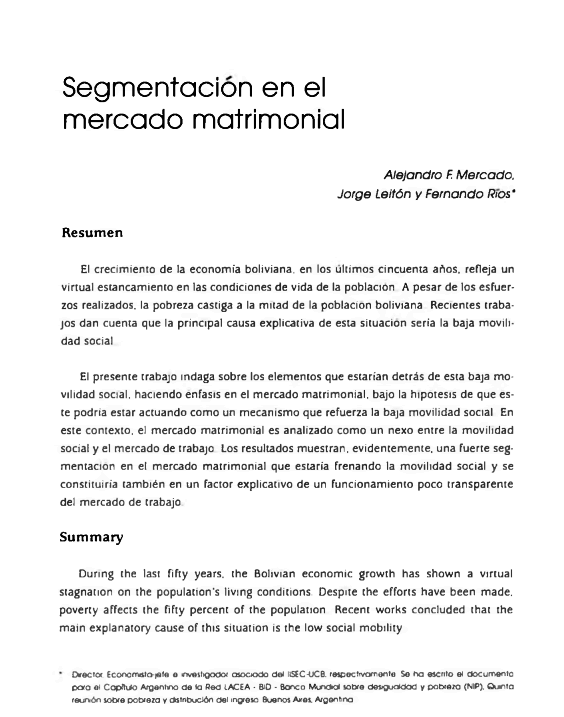Marriage Market Segmentation
DOI:
https://doi.org/10.35319/lajed.20043276Keywords:
Social Mobility, Marriage market, Labour marketAbstract
During the last fifty years, the Bolivian economic growth has shown a virtual stagnation on the population’s living conditions. Despite the efforts have been made, poverty affects the fifty percent of the population. Recent works concluded that the main explanatory cause of this situation is the low social mobility.
The present paper investigates on the elements that are behind this low social mobility. The binding hypothesis follow that the marriage market could be acting as a mechanism that reinforces the low social mobility. Moreover, the marriage market is considered as an important link between social mobility and the labour market. The results shows, an evident strong marriage market segmentation that would slowdown the social mobility and, is a factor that lead to misallocations in the labour market.
Downloads
References
Albridge, S. 2001. "Social Mobility: A discussion Paper". Performance and Innovation. Unit London. United Kingdom.
Andersen, L. E. 2001. “Social Mobility in Latin America". Instituto de Investigaciones. Socio-Económicas. Universidad Católica Boliviana. Documento de Trabajo. N° 03/2000.
Andersen, L. E. 2003. "Baja movilidad social en Bolivia: causas y consecuencias para el desarrollo”. Revista Latinoamericana de Desarrollo Económico. Instituto de Investigaciones Socio-Económicas. Universidad Católica Boliviana. Septiembre.
Arrow, K. 1973. "The Theory of Discrimination”. In Discrimination in Labour Markets.ed Orley Ashenfelter and Albert Rees. Princeton University Press.
Becker, G. 1971. "The Economics of Discrimination”. Chicago. IL: The University of Chicago Press.
Behrman, J. R. 1999. “Social Mobility: Concepts and Measurement" The Brookings Institution.
Behrman, J. R., N. Birdsall and M. Szekely. 1998. "Intergenerational Schooling Mobility and Macro Conditions and Schooling Policies in Latin America”. Inter American Development Bank. Office of the Chief Economist. Mimeo.
Blau, F. L. Kahn., and J. Waldfogel. 2002. "Understanding Young Women's Marriage Decisions: The Role of Labor and marriage Market Conditions". National Bureau of Economic Research. Working Paper 7510.
Caucutt, E., N. Guner, and J. Knowles. 2001. "Time of Births: A Marriage Market Analysis". University of Pennsylvania.
Ehrenberg, R. and R. Smith. 1991. "Modern Labour Economics Theory and Public Policy". Harper Collins Publishers Inc. Fourth Edition.
Ermisch, J. and M. Francesconi. 2002. "Intergenerational Social Mobility and Assortative mating in Britain". Working Papers of the Institute for Social and Economic Research. Colchester University of Essex.
Fernandez, M. 1995. "¿Empleo o desarrollo institucional?". Serie Estudios. Fundación Milenio. La Paz, Bolivia.
Hassler, J. and M. J. V. Rodriguez. 1998. IQ, Social Mobility and Growth. Institute for International Economic Studies. Stockholm University. Seminar Papers N° 635, January.
McConnell. C. y S. Brue. 1997. "Economía Laboral". España: Mc.Graw Hill.
Mercado. A., L. Andersen y B. Muriel. 2003. “Discriminación étnica en el sistema educativo y el mercado de trabajo en Bolivia". En Revista Latinoamericana de Desarrollo Económico. Instituto de Investigaciones Socio-Económicas. Universidad Católica Boliviana. Septiembre.
Mercado, A., L. Andersen, M Medinaceli, O. Nina, L. Lima, H. Villegas y S. Cerezo. 2003. "Movilidad social la clave para el desarrollo. Una agenda de políticas para la nueva decada". Programa de Investigación Estratégica en Bolivia (PIEB). Noviembre.
New Earnings Survey. 1997. United Kingdom.
New Earnings Survey. 1999. United Kingdom.
Raut, L. K. 1996. "Signalling Equilibrium, Intergenerational Mobility and Long-Run Growth". University of Hawan-Manoa. Draft. February.
Sandaram, C. 2002. "Specalization in the Marriage Market: When is it Valuable?". University of Arizona.
Villagra, A. y F. Ríos. 2004. "El mercado matrimonial en Bolivia". Serie de Tesis de Licenciatura en Economía. N° 801. Universidad Católica Boliviana






